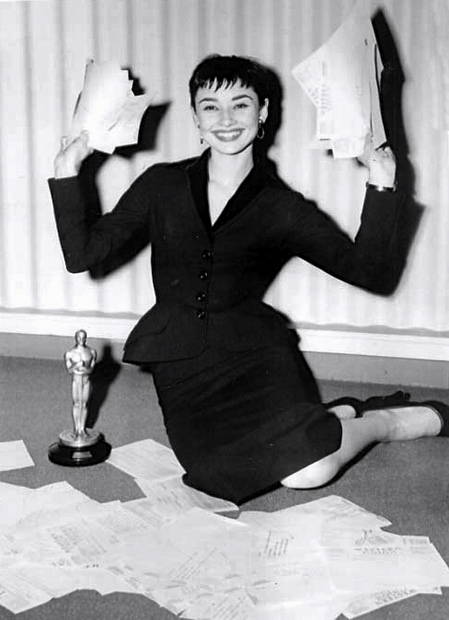The 1953 film Roman Holiday is one that I’ve watched quite a few times. If you know anything about the film and/or me, you won’t be surprised by that. I love Audrey Hepburn. I love Rome. I love romance. And I love bittersweet endings. And Roman Holiday has all four of those!
Speaking of Audrey Hepburn, I’ve shared this picture before but I’m going to share it again:
 That is Audrey Hepburn, the morning after she won the Best Actress Oscar for Roman Holiday. Roman Holiday was Audrey Hepburn’s motion picture debut and it continues to hold up as one of the greatest film debuts of all time. Watching how easily she controls and dominates the screen in Roman Holiday, you would think that she had made over a 100 films previously.
That is Audrey Hepburn, the morning after she won the Best Actress Oscar for Roman Holiday. Roman Holiday was Audrey Hepburn’s motion picture debut and it continues to hold up as one of the greatest film debuts of all time. Watching how easily she controls and dominates the screen in Roman Holiday, you would think that she had made over a 100 films previously.
The film tells a simple story, really. Audrey plays Ann, the crown princess of an unnamed country. Princess Ann is touring the world. The press is following her every move. Her royal handlers are carefully choreographing every event. Her ever-present bodyguards are always present to make sure that no one gets too close to her. In public, Ann is the epitome of royal discretion, smiling politely and always being careful to say exactly the right thing. But, in private, Ann is restless. Ann knows that she has never been allowed to see the real world and yearns to escape, if just for one night, and live a normal life. So far, her handlers have managed to keep her under control but then she arrives in Rome and…
…well, who can resist Rome?
Despite having been given a sedative earlier, Ann stays awake long enough to sneak out of her hotel room and see the enchanting Rome night life. Of course, the sedative does eventually kick in and she ends up falling asleep on a bench. It’s there that she’s discovered by an American, a cynical reporter named Joe Bradley (Gregory Peck). Not realizing who she is and, instead, assuming she’s just a tourist who has been overwhelmed by Rome, Joe allows her to spend the night at his apartment.
The next morning, Joe finds out who Ann actually is. Realizing that getting an exclusive interview with Ann could be his ticket to the big time, Joe and his photographer, Irving (Eddie Albert), rush back to Joe’s apartment. Joe doesn’t tell her that he’s a reporter. He just offers to take her on a tour of Rome. Ann, however, wants to experience Rome on her own.
What follows is a wonderful and romantic travelogue of the glory of Rome. Though Ann does explore on her own for a while, she eventually does meet back up with Joe and Irving. Whenever I watch Roman Holiday, I always try to put myself in the shoes of someone in 1953, sitting in the audience during the film’s first week of release. For many of them, this film may have been their first chance to ever see Rome. (The opening credits of Roman Holiday proudly announce that the entire film was shot on location, properly acknowledging the Rome is as much a star of this film as Hepburn, Peck, and Albert.) If you’re not already in love with Rome (and I fell in love with the city — and really, the entire country of Italy — the summer after I graduated high school), you will be after watching Roman Holiday.
(If you truly want to have a wonderful double feature, follow-up Roman Holiday with La Dolce Vita.)
The film’s most famous scene occurs at the Mouth of Truth and… well, just watch…
This scene was improvised, on the spot, by Gregory Peck. Audrey Hepburn’s scream was very much real as Peck didn’t tell her what he was planning on doing. As great as this scene is, it’s even better after you’ve actually been to Rome and put your own hand in the Mouth of Truth.
It’s a very sweet movie, one that stands as both a tribute to romance but also proof of what pure movie star charisma can accomplish. It’s not just that Audrey Hepburn gives a great performance as Princess Ann. It’s that Gregory Peck gives one of his most natural and surprisingly playful performance as well. It’s that Peck and Hepburn have an amazing chemistry. By the end of the film, you know that they deserve Rome and Rome deserves them.
And then there’s that ending, that bittersweet ending that always brings tears my mismatched eyes. It’s a sad (though not depressing) little ending but somehow, it’s also the only ending that would work.
Roman Holiday was nominated for best picture but it lost to From Here To Eternity.
That’s right — Roman Holiday and From Here To Eternity were released one after another.
1953 was a very good year.



